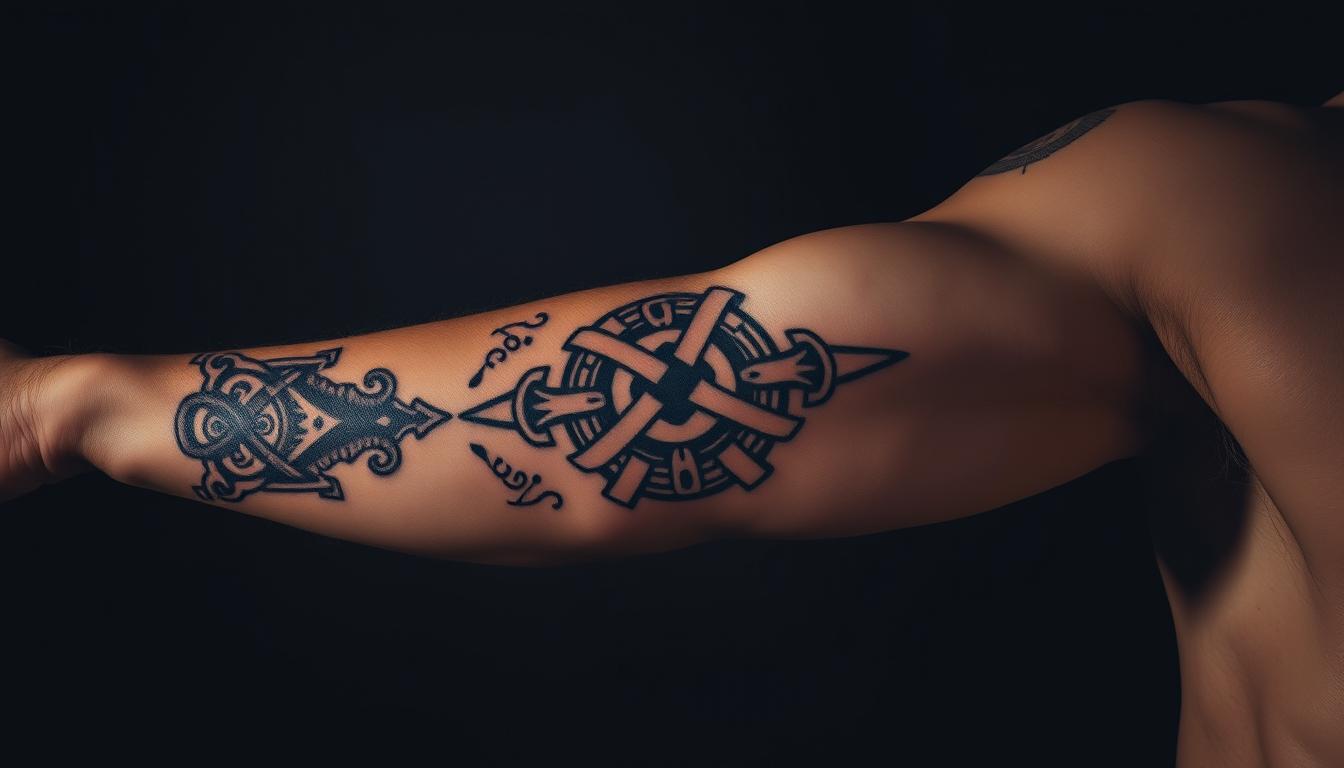
Celtic tattoos have captivated people for centuries with their intricate designs and rich symbolism. These ancient symbols continue to influence modern body art, offering a powerful way to express one’s heritage or personal strength.
The use of Celtic tattoos dates back to ancient warriors who used body art for spiritual protection and intimidation. The iconic blue color of these tattoos was achieved using the Woad plant, creating a distinctive and meaningful form of expression.
Today, warrior Celtic tattoos represent a connection to this ancient culture, combining intricate knotwork with powerful symbols that signify strength and courage.
Key Takeaways
- Celtic tattoos offer a meaningful way to express your heritage or personal strength through ancient symbols.
- These designs combine intricate knotwork with powerful symbols representing strength and courage.
- Historically, Celtic warriors used body art for spiritual protection and intimidation.
- Modern Celtic warrior tattoos continue this tradition, offering a unique form of self-expression.
- Celtic tattoos feature iconic blue coloring achieved through the use of the Woad plant.
The Ancient Art of Celtic Warrior Tattoos
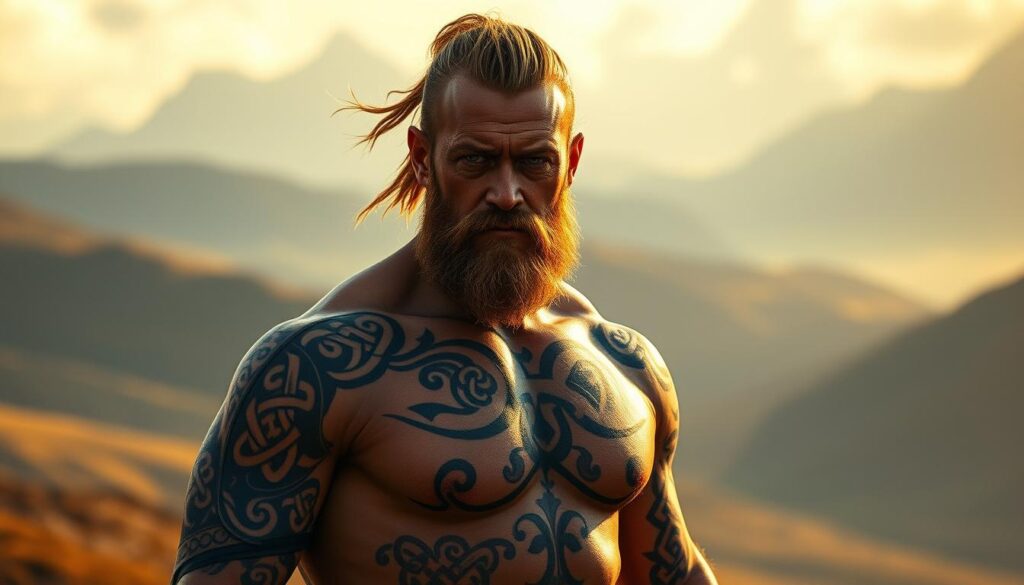
The art of Celtic warrior tattoos is deeply rooted in ancient Celtic culture. These tattoos are more than just beautiful artwork; they hold deep cultural and spiritual meaning, reflecting the beliefs and values of the Celts.
Celtic warrior tattoos date back thousands of years, with evidence suggesting that ancient Celtic warriors adorned their body with blue designs created from the Woad plant. These early tattoos served as spiritual protection in battle and symbols of status within Celtic warriors culture.
“The Celts used tattoos as a form of spiritual expression and to signify status within their communities.”
This practice not only showcased theirartbut also connected them to their heritage. The significance of these tattoos continues to inspire modern designs.
Celtic Warriors and Their Body Art Traditions
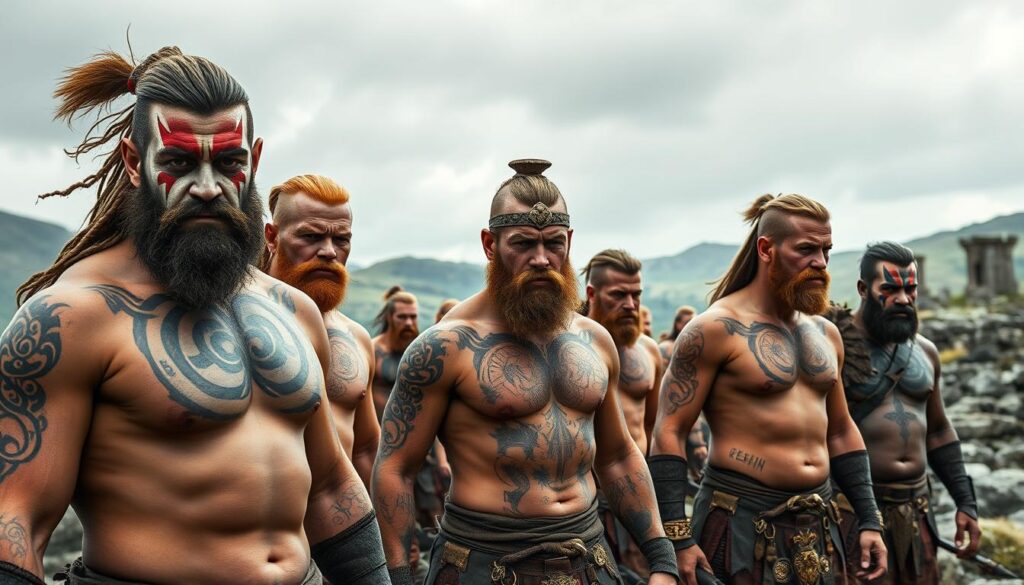
The Celts were known for their deep connection with nature, which was reflected in their spiritual beliefs and body art. Their tattoos often symbolized the connection between life and the spirit world, showcasing their love for natural elements like wind, time, and motion.
Celtic tattoos were created using the Woad plant, which produced indigo dye. This natural pigment was used to create intricate designs that represented their spiritual beliefs, clan affiliations, and personal accomplishments in battle. The Picts, a group of Celtic tribes, were particularly known for their elaborate body art, which likely included permanent tattoos featuring Celtic symbols and animal designs.
The process of creating these tattoos was a ritual, involving natural pigments and needle-like tools. Celtic warriors viewed their bodies as canvases for expressing their achievements and status within their tribe. These traditional Celtic tattoo traditions were passed down through generations, with certain designs reserved for those who had proven themselves in battle.
The Symbolism Behind Warrior Celtic Tattoos
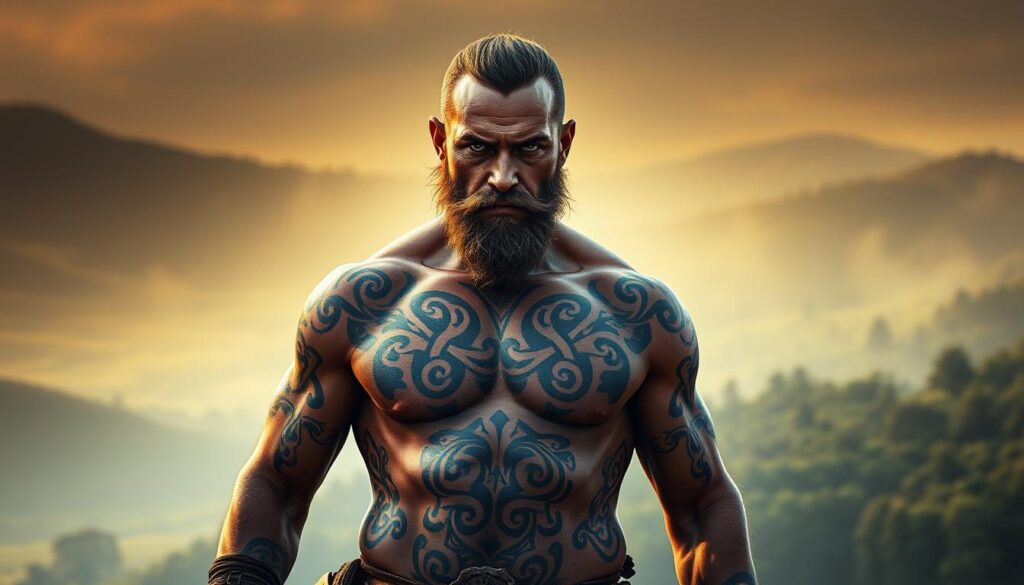
Celtic warrior tattoos embody a powerful symbolism that goes beyond mere decoration, representing the qualities that defined Celtic warriors. The Celts left behind remarkable Celtic symbols, but their meanings remain largely speculative. Most had multiple interpretations, with little definitive evidence.
These tattoos are rich with symbolism, representing qualities valued by Celtic warriors such as strength, courage, protection, and spiritual power. Each element in Celtic warrior designs carries specific meaning—from endless knots representing eternity to spirals symbolizing growth.
It’s crucial to distinguish between authentic Celtic symbols with historical roots and modern inventions. The most powerful designs combine multiple symbols to create a personalized Celtic warrior tattoo.
The Dara Knot: Symbol of Strength and Endurance
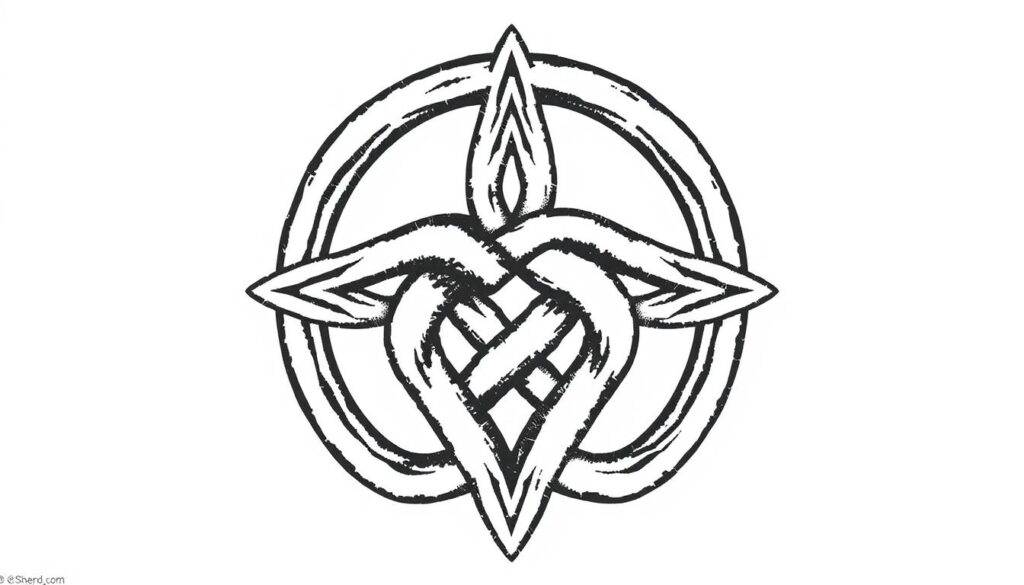
Among the various Celtic knots, the Dara Knot stands out as a powerful emblem of endurance and strength. This intricate design is deeply rooted in Celtic tradition, symbolizing the complex root system of an ancient oak tree. The Dara Knot derives its name from the Gaelic word “doire,” meaning “oak tree,” a symbol revered by the Celts for its unwavering strength and longevity.
The Dara Knot is not just a symbol; it’s a representation of the qualities that Celtic warriors aspired to embody: strength, endurance, and power. Its interconnected design also signifies the brotherhood of warriors and their connection to their ancestors, making it a potent symbol of collective strength.
- The Dara Knot is one of the most authentic and powerful Celtic symbols for warriors.
- It represents the root system of the mighty oak, sacred to the Celts.
- Warriors believed the Dara Knot would imbue them with the oak’s qualities.
- The design symbolizes brotherhood and connection to ancestors.
- As a tattoo, it works well on the chest, back, or upper arm.
The Dara Knot is a Celtic symbol that continues to inspire those who wear it, serving as a reminder of the importance of resilience and unity. Its timeless design makes it a popular choice for those seeking to honor their heritage or embody the qualities of Celtic warriors.
The Celtic Tree of Life: Balance and Power
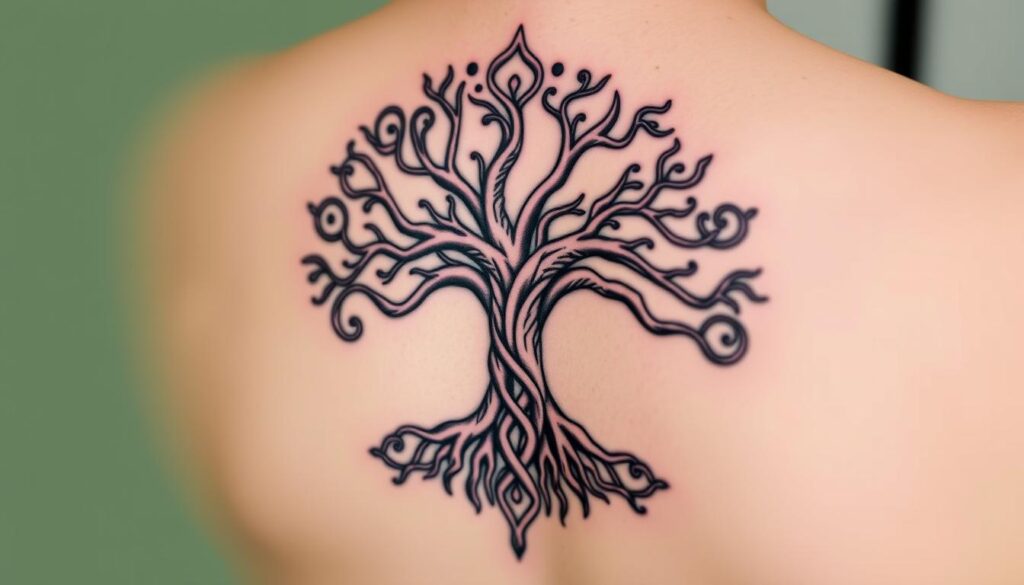
Celtic warriors revered the Tree of Life for its representation of the interconnectedness of all things. The Celtic Tree of Life symbolizes balance and harmony, while also embodying strength. Its symmetrical design, with branches mirroring roots, creates an eternal circular shape, representing the cycle of life, death, and rebirth.
This symbol was crucial for Celtic warriors, as it reminded them of the unity and connection among all aspects of existence. The Tree of Life tattoo design works well as a larger piece on the back or chest, where its intricate details can be fully appreciated.
The Trinity Knot (Triquetra): Mind, Body, and Spirit
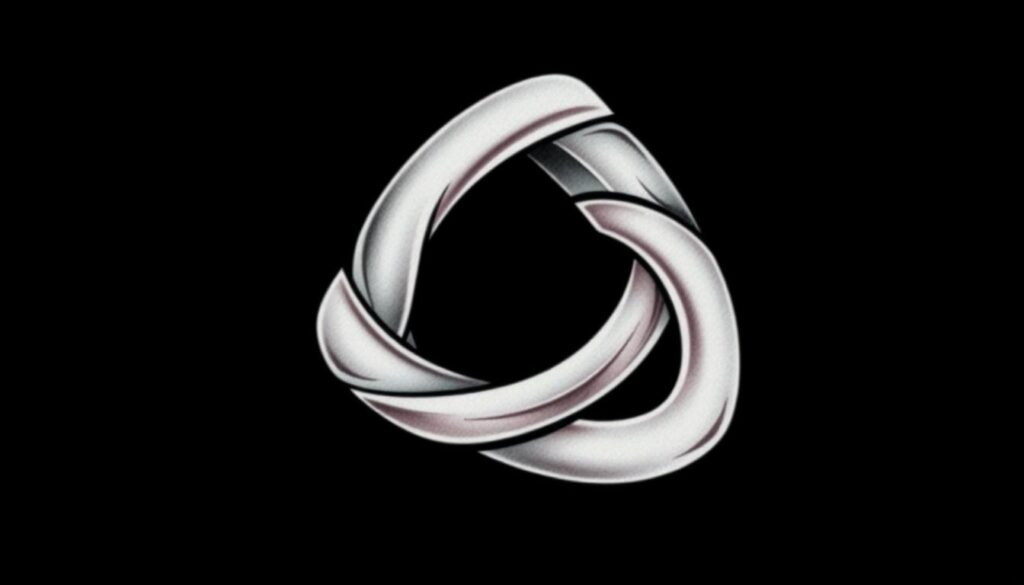
The Triquetra, or Trinity Knot, is an ancient Celtic emblem that represents the unity of mind, body, and spirit. This symbol has been a significant part of Celtic art, appearing in the Book of Kells and carved into stonework across the centuries.
The Trinity Knot features three interconnected loops, symbolizing the eternal connection between the three elements. It is often associated with the holy trinity, but its origins predate Christianity, representing the cycle of life and the unbreakable nature of the spirit.
For Celtic warriors, the Trinity Knot was a powerful symbol of courage and strength, reminding them that while the body might perish, the spirit continues. As a tattoo, it works well in various sizes and placements, from a small design on the wrist to a larger piece incorporated into broader Celtic artwork.
The Ailm: Symbol of Inner Strength and Resilience
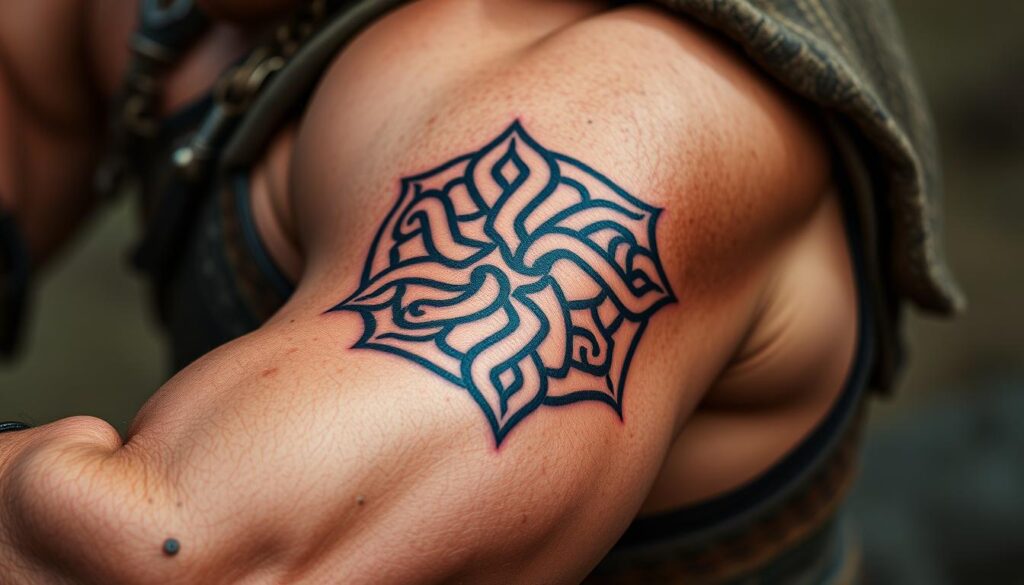
The Ailm is an ancient Celtic symbol derived from the Ogham alphabet, representing the pine tree and embodying inner strength. It’s believed to signify resilience, a trait that was highly valued by Celtic warriors. The pine tree, which the Ailm represents, remains green throughout the harshest winters, symbolizing the ability to persevere through adversity.
The Ailm’s design is relatively simple, typically featuring a square cross within a circle. This straightforward structure makes it versatile for various tattoo placements, allowing individuals to incorporate this powerful symbol into their body art with ease.
The significance of the Ailm can be seen in several aspects:
– The Ailm symbol, derived from the ancient Ogham alphabet, represents the pine tree—a symbol of resilience that remains green even through the harshest winters.
– For Celtic warriors, the Ailm embodied inner strength and the ability to persevere through challenges, making it a powerful talisman before entering battle.
– Unlike more complex Celtic designs, the Ailm features a relatively simple structure—typically a square cross within a circle—making it versatile for various tattoo placements.
– This symbol was believed to connect warriors with their inner reserves of courage and determination, helping them face adversity with a calm and resilient spirit.
– The Ailm’s association with healing and inner peace also made it a symbol of recovery and regeneration after battle, representing the warrior’s journey from conflict to restoration.
Incorporating the Ailm into a tattoo design can serve as a potent reminder of one’s inner strength and resilience. Its rich history and symbolism make it a compelling choice for those looking to embody the spirit of Celtic warriors.
Celtic Shield Knots for Protection
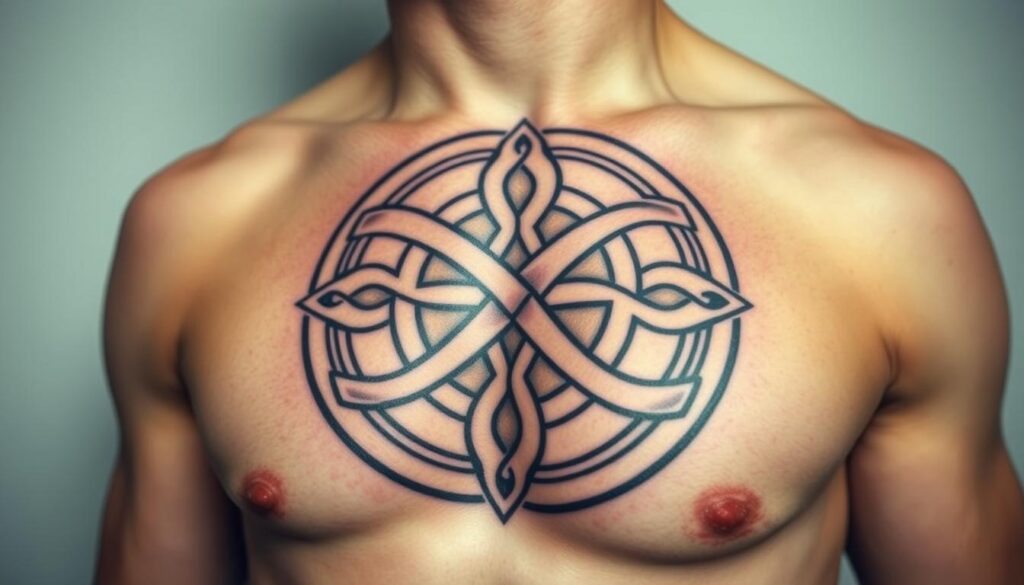
Shield Knots in Celtic art are specifically designed to offer protection against negative forces. These distinctive knots feature four corners or quadrants, representing the four cardinal directions and creating a complete circle of protection around the wearer.
Celtic Shield Knot tattoos are often placed over vital areas like the chest or back, symbolically protecting the wearer’s most vulnerable points. The intricate interlacing patterns of these knots were believed to confuse and trap evil spirits, preventing them from causing harm.
By incorporating a Celtic Shield Knot into a tattoo design, individuals can symbolize their desire for defense against dark forces. These designs can be a powerful way to express one’s commitment to protection and spiritual defense.
Celtic Warrior Animal Symbols
The use of animal symbols in Celtic warrior tattoos reflects the deep connection between nature and warrior culture. These symbols were not just decorative; they carried significant meaning and were believed to imbue the wearer with certain qualities.
The Celtic Bear
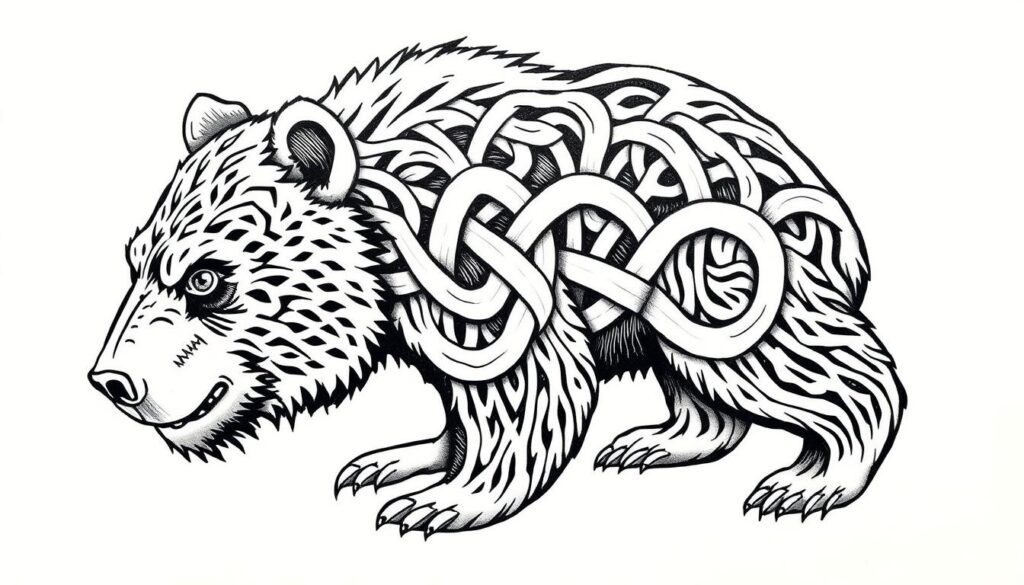
The Celtic bear is a potent symbol of courage and fearlessness. In Celtic culture, bears were revered for their strength and protective nature, making them an ideal symbol for warriors seeking to embody these qualities. A Celtic bear tattoo can represent a person’s inner strength and their ability to face challenges head-on.
The Celtic Wolf
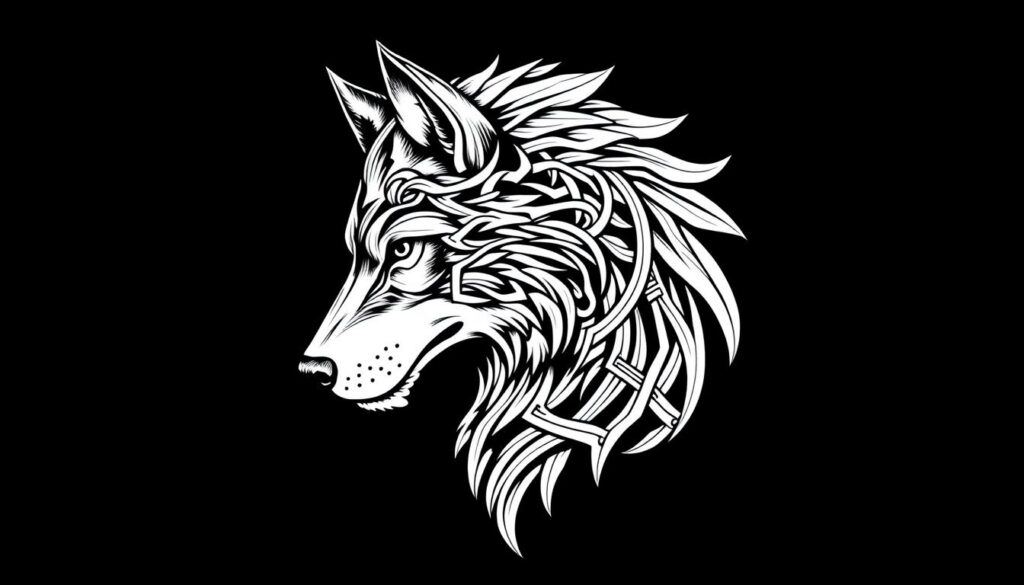
The Celtic wolf is another significant animal symbol, representing power and loyalty. Wolves were admired for their fierce loyalty to their packs and their ability to thrive in challenging environments. A Celtic wolf tattoo can signify a person’s commitment to their community and their own resilience.
The Celtic Raven
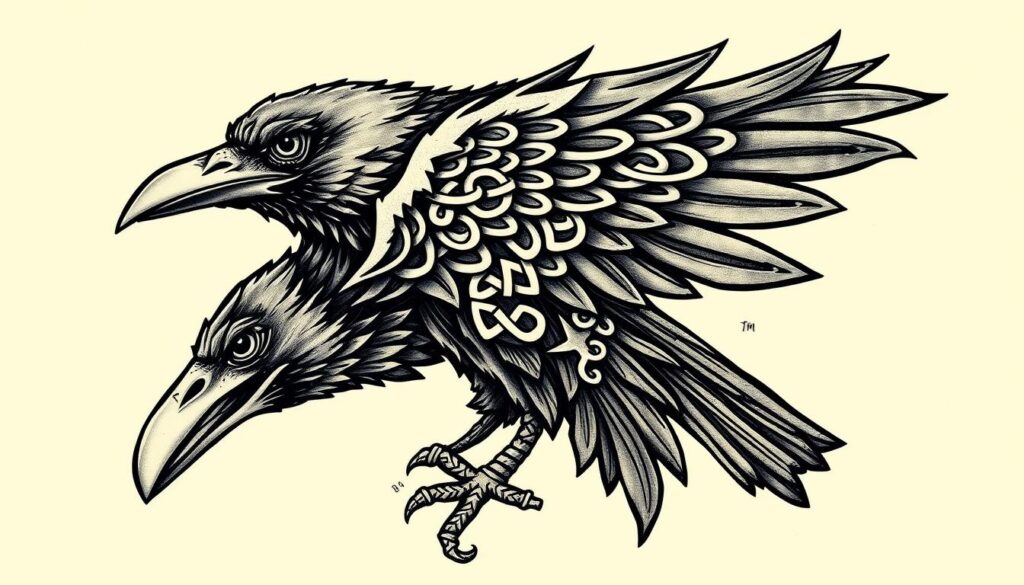
In Celtic mythology, the raven is associated with wisdom and foresight. Ravens were considered messengers between the mortal world and the spiritual realm, and their presence was often seen as a sign of significant events. A Celtic raven tattoo can represent a person’s connection to Celtic culture and their appreciation for the mysteries of life and death, embodying spirituality.
Celtic Dragon Tattoos: Guardians of Wisdom
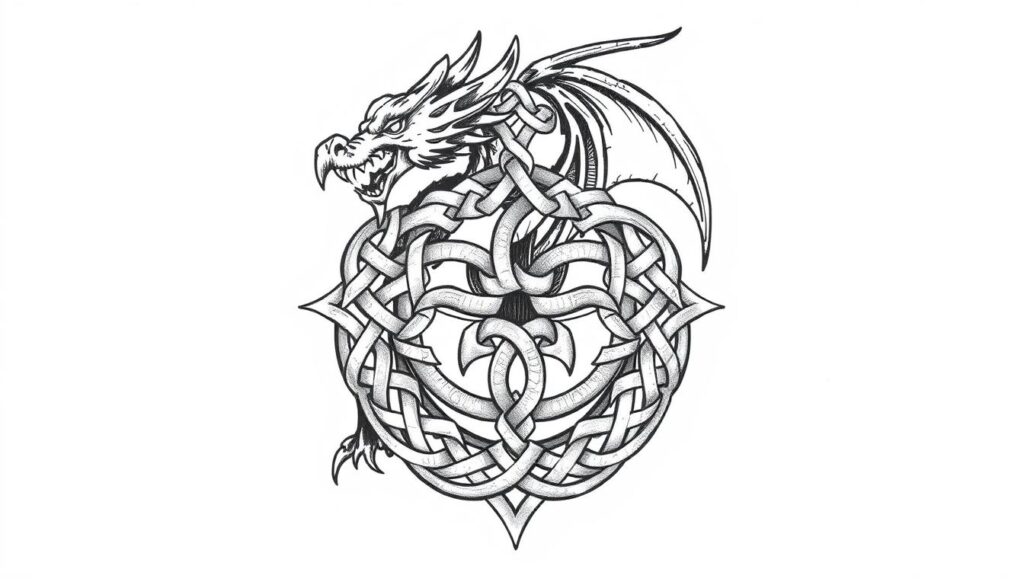
The Celtic dragon, a majestic creature, represents independence, leadership, and the guardianship of ancient wisdom. In Celtic culture, dragons were seen as powerful guardians of wisdom, treasure, and sacred places, making them ideal symbols for warriors.
Celtic dragon tattoos often feature the dragon in a circular design, biting its own tail, symbolizing the eternal cycle of life and death. The intricate knotwork in these designs represents the complexity and mystery of these mythical creatures, connecting them to ancient wisdom.
These tattoos work well as larger pieces, wrapping around arms, legs, or across the back, showcasing their sinuous forms following the body’s natural contours.
Authentic vs. Modern Celtic Warrior Designs
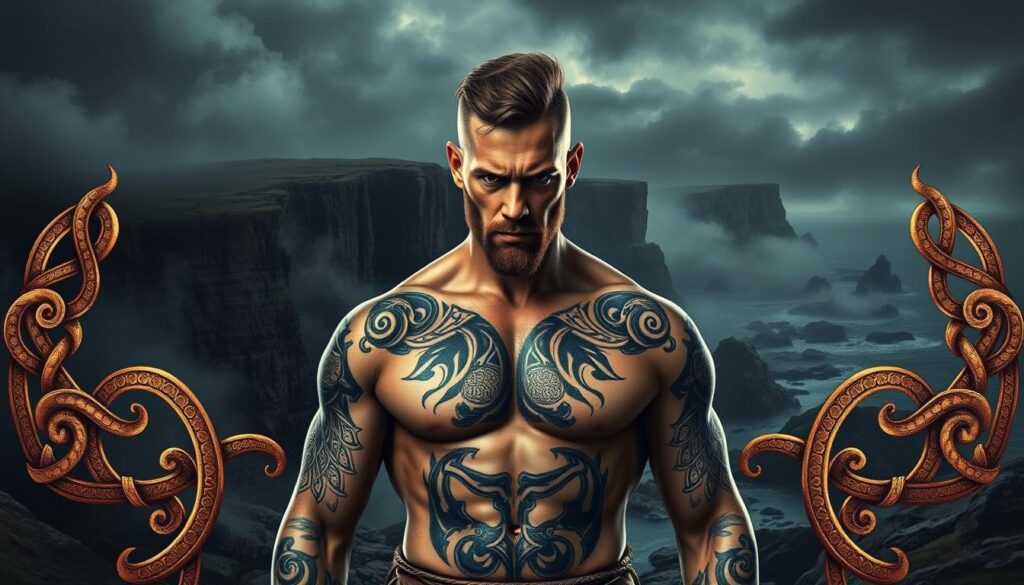
Authentic Celtic warrior tattoos draw from ancient artifacts, whereas modern designs incorporate fresh artistic perspectives. Celtic tattoos are heavily tied to nature and the five elements.
Authentic Designs are based on historical artifacts and ancient manuscripts. Modern interpretations often incorporate contemporary elements, sometimes lacking historical basis.
| Design Characteristics | Authentic Celtic | Modern Celtic |
|---|---|---|
| Historical Basis | Rooted in ancient artifacts and manuscripts | Often created for aesthetic appeal |
| Symbolic Elements | Feature specific cultural symbols | May prioritize modern artistic elements |
| Knotwork | Follows traditional mathematical principles | May deviate from traditional methods |
For a meaningful Celtic warrior tattoo, researching historical designs and working with knowledgeable artists can result in authentic and powerful body art.
Popular Placements for Warrior Celtic Tattoos
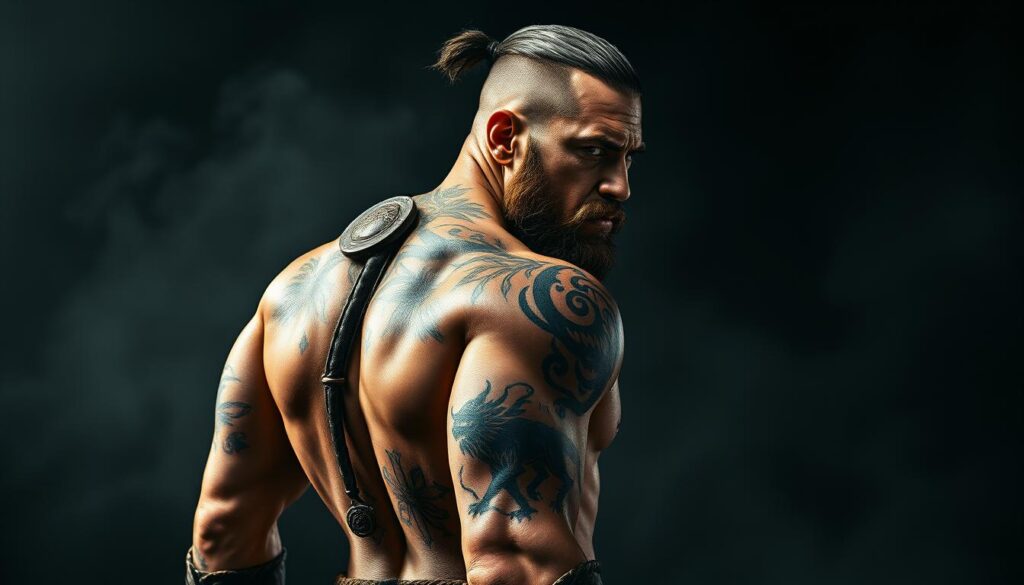
When it comes to showcasing your inner Celtic warrior, the placement of your tattoo is just as important as the design itself. The right placement can enhance the tattoo’s meaning and aesthetic appeal.
Chest and Back: Traditional Warrior Placement
The chest and back are traditional placements for warrior Celtic tattoos, offering a large canvas for intricate designs. These areas allow for bold statements about one’s strength and warrior spirit.
Arms and Shoulders: Displaying Strength
Arm and shoulder tattoos display Celtic warrior symbols prominently, making a bold statement about one’s strength and warrior spirit in daily life. The natural musculature of these areas enhances warrior symbols like the Dara Knot or Celtic bear.
| Placement | Design Suitability | Aesthetic Appeal |
|---|---|---|
| Chest | Intricate designs, Celtic knots | Bold statement |
| Back | Large-scale designs, Celtic warriors | Dramatic impact |
| Arms and Shoulders | Celtic symbols, Shield Knots | Visible, dynamic |
The chosen placement significantly impacts the overall body art, making it a personal and meaningful expression of one’s identity.
Incorporating Personal Elements into Celtic Designs
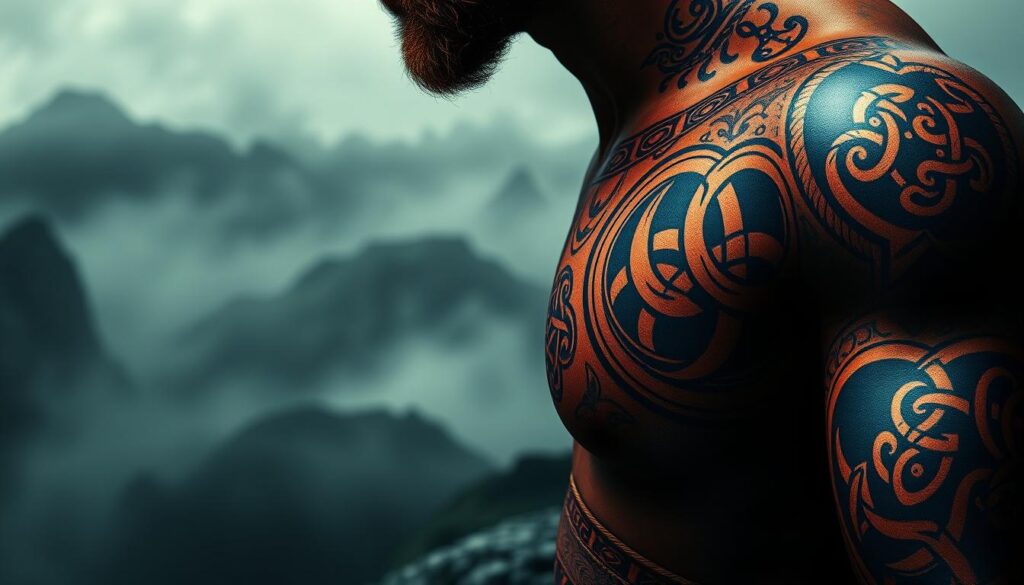
Celtic tattoos are not just about ancient designs; they’re also a canvas for personal expression. Many people choose to add unique elements like initials or significant dates to their Celtic tattoos, making them truly one-of-a-kind.
By incorporating personal elements into Celtic designs, you can create a Celtic tattoo that not only honors your heritage but also tells your personal story. This can include family names, meaningful phrases, or personal totems woven into the Celtic knotwork.
- Family names or significant dates can be seamlessly integrated into Celtic designs.
- Personal totems or birthstones can add layers of meaning to your Celtic warrior tattoo.
As noted by tattoo artists, good communication is key to creating a custom Celtic tattoo that include[s] Celtic symbolism while reflecting your personal identity. By working closely with your artist, you can ensure that your tattoo is both meaningful and aesthetically pleasing.
Color Choices for Celtic Warrior Tattoos
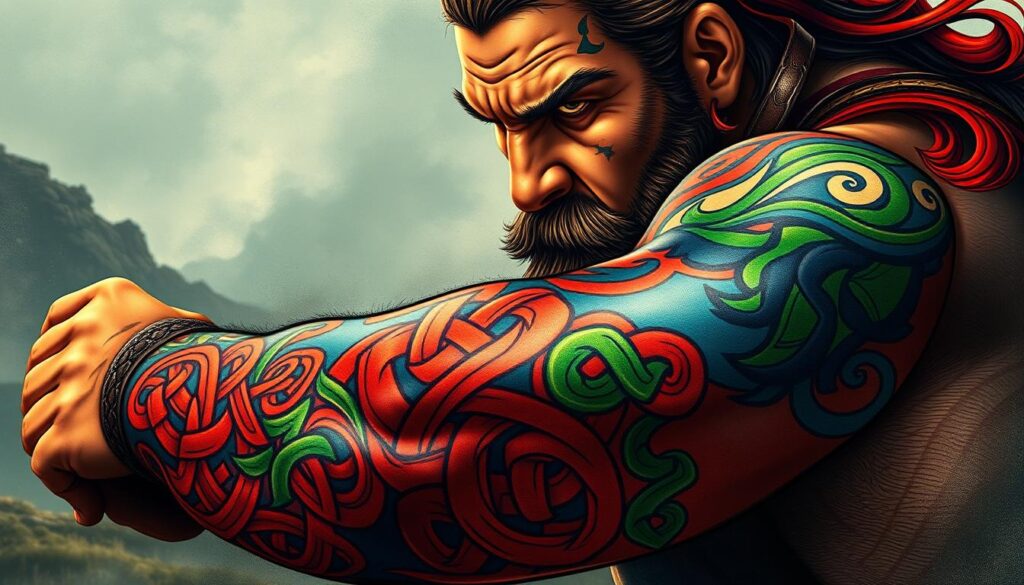
When it comes to Celtic warrior tattoos, the choice of color can greatly impact the overall design and its symbolism. Historically, Celtic tattoos were made using the Woad plant, producing a distinctive blue-indigo color.
Modern Celtic tattoo designs offer a range of color options, from traditional black ink to vibrant neo-traditional styles. Earth tones like deep greens and browns can enhance the natural world connection important in Celtic spirituality.
| Color | Symbolism |
|---|---|
| Blue-Indigo | Traditional, Authenticity |
| Earth Tones | Connection to Nature |
| Red Accents | Warrior’s Blood or Passion |
The choice of color in tattoos can significantly impact the design, with monochromatic approaches emphasizing intricate knotwork and colorful approaches highlighting symbolic elements.
Finding the Right Artist for Your Celtic Tattoo
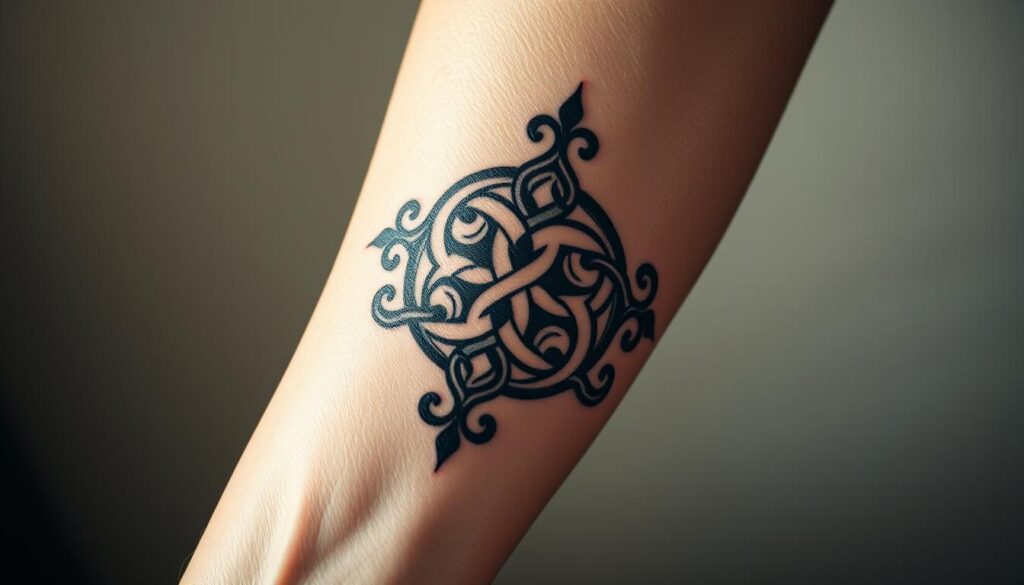
To ensure your Celtic tattoo is both authentic and unique, finding the right artist is key. Interest in Celtic tattoos is growing as people connect with their heritage. Look for an artist with experience in Celtic knotwork and symbolism.
When selecting an artist, review their portfolio for technical skill and understanding of authentic Celtic tattoo designs. The best artists balance historical accuracy with innovation, creating designs that honor traditions while feeling fresh.
Conclusion: Honoring the Warrior Spirit Through Celtic Art
Embracing the warrior spirit through Celtic tattoos means tapping into a legacy of strength and resilience. These designs connect you with Celtic culture and its rich heritage, featuring animals and nature that symbolize courage and power. By understanding the symbols behind your tattoo, you create a meaningful link to your heritage or personal values. Warrior Celtic tattoos serve as a reminder of your inner strength, inspiring your journey. Choose a design that resonates with your spirit.
